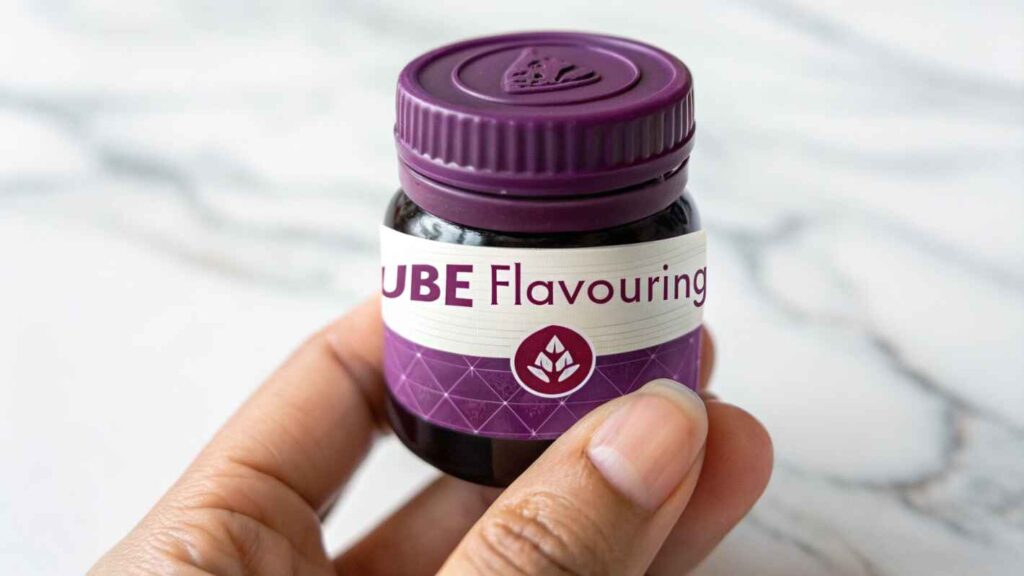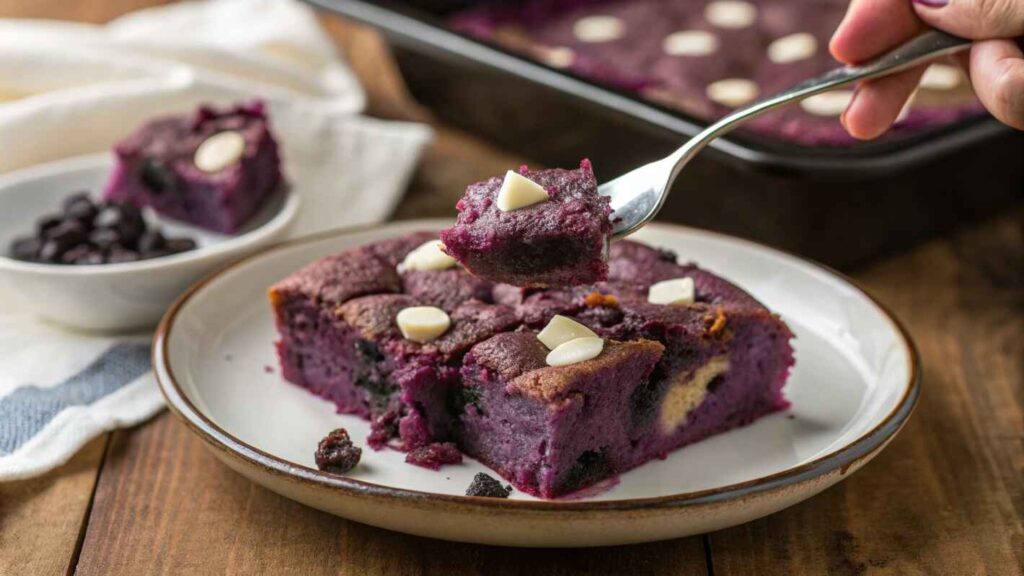Have you ever wondered, ‘What kind of fruit is ube?’ This purple yam from the Philippines is so vivid it almost looks otherworldly. Meet ube, a unique and enchanting tuber that’s taking the world by storm with its vibrant color and sweet flavor. Whether you’re a foodie or simply curious, this guide will take you on an exciting journey into the world of ube!
Table of Contents
What is Ube?
Purple Yam (pronounced oo-beh) is not just any tuber; it’s a purple yam, scientifically known as Dioscorea alata. It’s different from other yams due to its deep purple color and sweet taste. Often confused with taro and sweet potatoes, Purple Yam stands out with its unique characteristics.
The Rising Popularity of Ube Globally
In recent years, Dioscorea alata has exploded in popularity across the globe. From Instagram-worthy desserts to traditional Filipino dishes, Dioscorea alata has found its way into the hearts (and stomachs) of millions. But why is ube suddenly everywhere? It’s not just its photogenic qualities but also its versatility in cooking that has chefs and home cooks alike experimenting with this colorful yam.

Understanding Ube
Botanical Background of Ube
Ube is part of the Dioscoreaceae family, originating in the tropics of Asia, particularly in the Philippines. It has been cultivated for its starchy roots and as a natural dye for centuries in Southeast Asia. The plant thrives in warm climates and is now grown in various parts of the world including Africa, the Caribbean, and America.
The Difference Between Ube and Taro
It’s easy to confuse Purple Yam with taro, but here’s a quick tip: ube is purple all the way through, while taro is white with purple specks Purple Yam has a sweeter, more vanilla-like flavor which makes it perfect for desserts, whereas taro is more neutral.
Nutritional Profile of Ube
Not only is Purple Yam a treat for the eyes, but it’s also packed with nutritional benefits. Let’s dive into the numbers that make Purple Yam not just delicious, but also a healthy choice:
| Nutrient | Amount |
|---|---|
| Calories | 140 |
| Carbohydrates | 27 g |
| Dietary Fiber | 4 g |
| Sugar | 0.5 g |
| Protein | 1 g |
| Fat | 0.1 g |
| Vitamin C | 2.3 mg |
| Potassium | 816 mg |
“Ube is not just good, it’s great for your health too! With its low fat and high fiber content, it’s a fantastic addition to any diet.” – Nutrition Expert
Ready to learn more about how Purple Yam is used in cooking and its various health benefits? Stay tuned for the next sections where we dive deeper into the delicious world of Purple Yam!

Culinary Uses of Ube
Traditional Filipino Dishes Featuring Ube
Ube has been a staple in Filipino cuisine for centuries, charming everyone with its sweet and nutty flavor. One of the most beloved uses of Purple Yam is in halo-halo, a popular Filipino dessert that features crushed ice, evaporated milk, and various ingredients like leche flan, sweetened beans, and of course, ube ice cream. The Purple Yam gives it a distinct purple hue and a creamy texture that’s simply irresistible.
Another traditional treat is Purple Yam halaya, a sweet and velvety jam made by boiling and mashing Purple Yam with milk, butter, and sugar. It’s often eaten on its own or used as a spread on bread, a filling for pastries, or a topping for sticky rice.
Modern Recipes and Innovations
As Purple Yam gains popularity worldwide, creative chefs and home cooks are finding new ways to incorporate this vibrant yam into all sorts of dishes. From Purple yam pancakes and waffles to Purple yam doughnuts and even Purple yam macarons, the possibilities are endless. These dishes not only taste delightful but also make for stunning visuals that light up social media feeds!
Have you ever thought about starting your day with some Purple yam pancakes topped with coconut syrup? Or maybe treating yourself to an Purple yam latte? The sweet, vanilla-like flavor of Purple yam pairs wonderfully with creamy textures, making it a perfect addition to your coffee.
Ube as a Natural Food Coloring
Aside from its use in desserts and drinks, Purple yam is also celebrated for its natural deep purple color. It’s an excellent alternative to artificial food colorings, providing a vibrant color to food products without the chemicals. This makes Purple yam a favorite among health-conscious consumers and parents looking to make food fun and nutritious for their kids.
“Using Purple Yam as a natural food dye is not only healthy but also environmentally friendly. It reduces our reliance on synthetic ingredients, promoting a cleaner and greener way to enjoy our food.” – Eco-friendly Chef
Excited about the versatility of Purple yam yet? Wait till you hear about the health benefits this superb tuber offers. The next part of our guide dives into why Purple yam is not just a treat for the taste buds but also a boon for your health.

Health Benefits of Ube
Antioxidant Properties
Purple Yam isn’t just pleasing to the eye; it’s also packed with powerful antioxidants. These compounds help fight off free radicals, which are unstable molecules that can cause cell damage and contribute to various diseases. The vibrant purple color of Purple yam comes from anthocyanins, a type of antioxidant that has been linked to a lower risk of heart disease, certain cancers, and brain disorders. Eating Purple yam can be a delicious way to boost your body’s defenses against these issues.
Potential Benefits for Blood Sugar Control
For those managing diabetes or concerned about blood sugar levels, Purple yam might be a valuable addition to your diet. It has a low glycemic index compared to other starchy vegetables, which means it causes a slower rise in blood sugar levels. This is crucial for maintaining stable energy levels and preventing the spikes and crashes that can occur with other sugars and carbs.
How Ube Supports Heart Health
Heart health is another area where Purple yam shines. The fiber in Purple yam can help reduce cholesterol levels by binding with cholesterol particles in your digestive system and removing them from your body. This process helps lower the risk of heart disease and keeps your cardiovascular system running smoothly. Plus, the potassium in Purple yam aids in blood pressure regulation, further supporting heart health.
“Incorporating Purple Yam into your diet can contribute to a heart-healthy lifestyle, thanks to its fiber and potassium-rich profile.” – Cardiologist
With all these benefits, it’s clear that Purple yam does more than just liven up your plate—it’s a nutritional powerhouse that supports overall health. In the next part, we’ll explore how to grow and harvest Purple yam, and some common challenges growers face, so you can try cultivating this remarkable tuber yourself or simply appreciate the effort that goes into bringing it to your table.
Growing and Harvesting Ube
Ideal Conditions for Growing Purple Yam
Ube thrives in tropical climates where the temperature is consistently warm, with plenty of rainfall. If you’re thinking about growing Purple yam, it’s important to ensure it has a humid, moist environment. The soil should be well-draining yet retain enough moisture to support its growth. Purple yam prefers a pH between 5.5 and 6.5, which is slightly acidic to neutral. Ample sunlight is crucial, but the plant can also tolerate partial shade.
Common Challenges in Cultivating Ube
Growing Purple yam isn’t without its challenges. One of the major difficulties is disease management. Purple yam plants are susceptible to several diseases, including root rot and fungal infections, which are exacerbated by overly wet conditions or poor soil drainage. Pests like nematodes and weevils can also pose problems by attacking the roots, potentially reducing yield and quality.
To manage these issues, it’s crucial to practice crop rotation and use resistant varieties when available. Ensuring good field hygiene and proper irrigation techniques can also help keep diseases and pests at bay.
Harvesting and Post-Harvest Practices
Purple Yam is typically ready for harvest 6 to 8 months after planting. The timing is important as harvesting too early can lead to underdeveloped tubers, while harvesting too late can cause the tubers to become too woody and less flavorful. Once harvested, Purple yam should be handled with care to prevent bruising. It should be stored in a cool, dry place and ideally used within a week or preserved through freezing or making into Purple yam halaya for longer shelf life.
“Proper post-harvest handling of Purple Yam is essential to maintain its quality and prolong its shelf life. Immediate cooling after harvest can significantly reduce spoilage.” – Agricultural Expert
With a better understanding of how to grow and care for ube, perhaps you’re inspired to try your hand at cultivating this vibrant tuber, or maybe you’ll just appreciate the next ube dessert you enjoy even more, knowing the effort that went into producing it.

Common Problems with Ube
Availability Issues in Non-native Regions
One of the main challenges with Purple Yam is its availability outside of its native regions. As a tropical plant, Purple yam isn’t readily available in colder climates, making it a rare find in local markets. However, the demand for Purple yam has encouraged many stores and online retailers to stock frozen Purple yam or Purple yam powder, which can be a great alternative. For those in the US or Europe, checking Asian markets or specialty food stores might yield fresh or processed ube.
Overcoming Bland or Inconsistent Flavors
Another issue faced by Purple Yam enthusiasts is the variability in flavor, which can range from intensely sweet and flavorful to somewhat bland. This inconsistency often depends on the cultivation conditions. To ensure the best taste, opt for Purple yam from reputable sources or, if you’re growing it yourself, pay close attention to soil quality and proper harvesting times. Adding a touch of vanilla or coconut can also enhance the natural sweetness of Purple yam in recipes.
Allergic Reactions and How to Handle Them
While allergies to ube are rare, they can occur. Symptoms might include itching, swelling, or gastrointestinal distress. If you or someone you know has a suspected allergy to Purple yam, it’s important to consult a healthcare provider for testing and advice. For those with confirmed allergies, alternatives like purple sweet potatoes can offer a similar color and texture without the allergic reactions.
“Understanding the challenges and solutions related to Purple Yam can enhance your cooking and eating experience, ensuring you get the best out of this unique tuber.” – Culinary Expert
Conclusion
From its deep purple hues to its sweet, vanilla-like flavor, Purple yam is a versatile and nutritious addition to any diet. Whether used in traditional Filipino dishes, modern desserts, or as a natural food coloring, Purple yam has made a significant impact on culinary trends worldwide. By understanding the common problems and how to address them, you can enjoy Purple Yam in all its glory, adding a splash of color and a dose of health to your meals.
So, the next time you come across Purple yam at a market or in a recipe, remember the rich history and the effort that goes into producing each vibrant tuber. Enjoy the journey of discovering and using Purple yam, a true gem of the culinary world!
